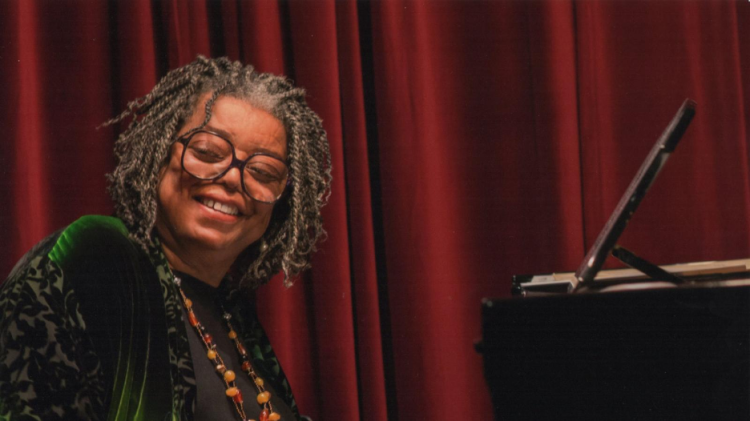Mirrors. Mary Watkins.

Mirrors, by Mary D. Watkins, is a dreamlike and meditative piece for solo piano. The left hand plays a repeated triplet eighth note figure for the entire piece, endlessly cascading like gentle waves upon a shore. The right hand plays a peaceful and elongated melody which, like the left hand, rises and falls, but more gently and over longer periods of time. The four-bar melody is quite simple, changing little throughout the first third of the piece.
This piece is made up of three sections, the first of which builds upon this initial four-bar melody. The harmony and melody carefully shift lower and lower, until in measure 27 when we return to the initial harmony, with a melody soaring higher than before. Then we cycle through the same series of harmonic shifts until measure 54, when chopin-esque flourishes are added to the melody and we enter the second section of this piece. Watkins indicates at the beginning of the piece to take time when playing these flourishes to avoid rhythmic rigidity. One should avoid making too much of these gestures, dramatically-speaking. This section ends with a chord held on a fermata and a break before playing again.
The third section, beginning in measure 70, is very similar to the opening material, but now the melody is in two voices, which remains largely consistent until the end. In measure 88 we finally reach rhythmic closure in the right hand, allowing the left hand to climb up the keyboard to the upper registers. The right and left hand join in the triplet rhythm which has persisted for the entire piece and make their way into the distance.
There are a few musical considerations to keep in mind when learning this piece. Because of the repetitive nature of both the left and right hand, subtle dynamic shaping is necessary to retain interest. One may consider emphasizing the melody slightly more on the first or second phrase of every eight-measure sentence, in addition to creating a gentle dynamic arch within each phrase. One should also experiment with color, this is a great piece to experiment with using different key attacks, as well as the una corda pedal.
Overall, this piece should maintain its placidity, never becoming too excited.
Some guidance from Mary Watkins, through Professor Gregory Walker at CU Denver: the piece should remain dreamlike for a majority of the time, while the third section, following the fermata in measure 69, can act as a sort of moment of awakening before falling back gently to sleep. The final chord should not be too placed, but instead evoke a sense of the music continuing on forever.
Practice Strategies:
- Practice the melody slowly, with the left hand, and with very strict rhythm before working on freeing up the right hand
- Practice the melody at a faster tempo, perhaps while blocking the left hand as chords, in order to get a sense for the longer phrases
- Map out the structure of the phrases, in order to further plan the long-term arc of the piece
- Experiment with ½ and ¼ damper pedal changes between measures of the same harmony, to further create a sense of an uninterrupted dream
Mary D. Watkins (b. 1939), a Denver native, has composed instrumental music for individual performers, theatrical productions, films, and symphony orchestras. The music has been performed by the Berkeley Symphony Chamber Orchestra, Richmond (VA), Chamber Orchestra, Rohnert Park Symphony, Palo Alto Philharmonic, The Women’s Philharmonic Orchestra, Camellia Symphony Orchestra, Plymouth Symphony, and The New Black Music Repertory Ensemble of Chicago, among others. For more information on her works, visit her website.
Sources
- Photo: Mary Watkins’ Website.
- Mary Watkins’ Website.
- Mary Watkins. Wikipedia.
Mirrors, by Mary Watkins. Performed by Nicholas Brewer.

